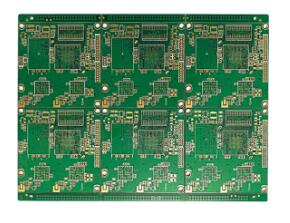Product name:HDI rigid-flex board
Board material: FR-4+PI
Board thickness: 0.15mm+1.2mm
Surface technology: Immersion gold
Copper thickness: 1OZ
Minimum line width/line spacing: 4mil/4mil
Use: automotive electronics
The HDI rigid-flex board used in high-density interconnect structure (HDI) is applied to automotive PCB, which greatly promotes the rapid development of HDI rigid-flex board technology. At the same time, with the development and improvement of PCB technology, the development of HDI rigid-flex board Researched and obtained a large number of applications, it is expected that the global supply of HDI rigid-flex board will increase substantially in the future. At the same time, the durability and flexibility of HDI rigid-flex board also make it more suitable for automotive electronics applications, gradually eroding the market share of rigid PCBs.
PCB manufacturers are aware that HDI rigid-flex board is light, thin, and compact, which is particularly suitable for the latest portable electronics and automotive electronics-these terminal products are currently boosting the output of HDI rigid-flex board. Therefore, industry insiders expect that HDI rigid-flex boards will surpass other types of PCBs in the next few years.
Although HDI rigid-flex board products are good, the manufacturing threshold is somewhat high. Among all types of PCBs, HDI rigid-flex board has the strongest resistance to harsh application environments, so it is favored by automotive electronics manufacturers. The HDI rigid-flex board combines the durability of a rigid PCB and the adaptability of a flexible PCB. PCB companies are increasing the proportion of such PCBs in overall production to take full advantage of the great opportunities that continue to grow in demand. Reducing the assembly size and weight of electronic products, avoiding wiring errors, increasing assembly flexibility, improving reliability, and achieving three-dimensional assembly under different assembly conditions is an inevitable demand for the increasing development of electronic products. Interconnection technologies that can meet the needs of three-dimensional assembly, such as light, light, and flexible, have been increasingly widely used and valued in the automotive electronics industry.

With the continuous expansion of the application field of HDI rigid-flex board, the flexible circuit board itself is also constantly developing, such as from single-sided flexible board to double-sided, multi-layer and even rigid-flex board, etc. The application of surface mounting technology and the material characteristics of the flexible substrate itself put forward more stringent requirements for the production of flexible boards, such as the treatment of the substrate, the alignment of layers, the control of dimensional stability, and the de-sticking Contamination, the reliability of small hole metallization and electroplating, and surface protective coating should all be highly valued
Material selection of HDI rigid-flex board.
When considering the design and production process of an HDI rigid-flex board, it is very important to make adequate preparations, but this requires certain professional knowledge and an understanding of the required material characteristics. The material selected for the HDI rigid-flex board is directly Affect the subsequent production process and its performance.
ipc chooses DuPont's (AP adhesive-free series) polyimide flexible substrate. Polyimide is a material with good flexibility, excellent electrical properties and heat resistance, but it has Larger hygroscopicity and not resistant to strong alkali. The reason for choosing a substrate without an adhesive layer is that the adhesive between the dielectric layer and the copper foil is mostly acrylic, polyester, modified epoxy resin and other materials, among which the modified epoxy resin adhesive is flexible Polyester adhesives have good flexibility but poor heat resistance. Although acrylic adhesives are satisfactory in terms of heat resistance, dielectric properties and flexibility, they need to be considered. The glass transition temperature (Tg) and pressing temperature are relatively high (around 185°C). At present, many factories use Japanese (epoxy resin series) substrates and adhesives to produce HDI rigid-flex board.
There are also certain requirements for the choice of rigid PCB. Lianshuo first chooses the lower cost epoxy glue board, because the surface is too smooth to stick firmly, and then chooses to use FR-4.G200 and other substrates with a certain thickness. Copper was etched away, but due to the difference between FR-4.G200 core material and PI resin system, Tg and CTE were not compatible. After thermal shock, the rigid-flex joint part warped seriously and could not meet the requirements, so the rigidity of PI resin series was finally selected. The material can be laminated with P95 base material, or simply laminated with P95 prepreg. In this way, the rigid-flex PCB board of the matched resin system can be laminated to avoid warping deformation after thermal shock. At present, many PCB substrate manufacturers have developed and produced some rigid PCB board materials specifically for HDI rigid-flex board.
For the adhesive part between the flexible PCB board and the rigid PCB board, it is best to use No flow (low flow) Prepreg for pressing, because its small fluidity is very helpful to the soft and hard transition area. Due to the overflow of glue, the transition area needs to be reworked or the functionality is affected. At present, many companies that produce PCB raw
materials have developed this kind of PP film and there are many specifications that can meet the structural requirements. In addition, for customers in ROHS, High Tg, Impedance
and other requirements, also need to pay attention to whether the characteristics of the raw material can meet the final requirements, such as the thickness specification of the PCB material, the dielectric constant, the TG value, and the environmental protection requirements.